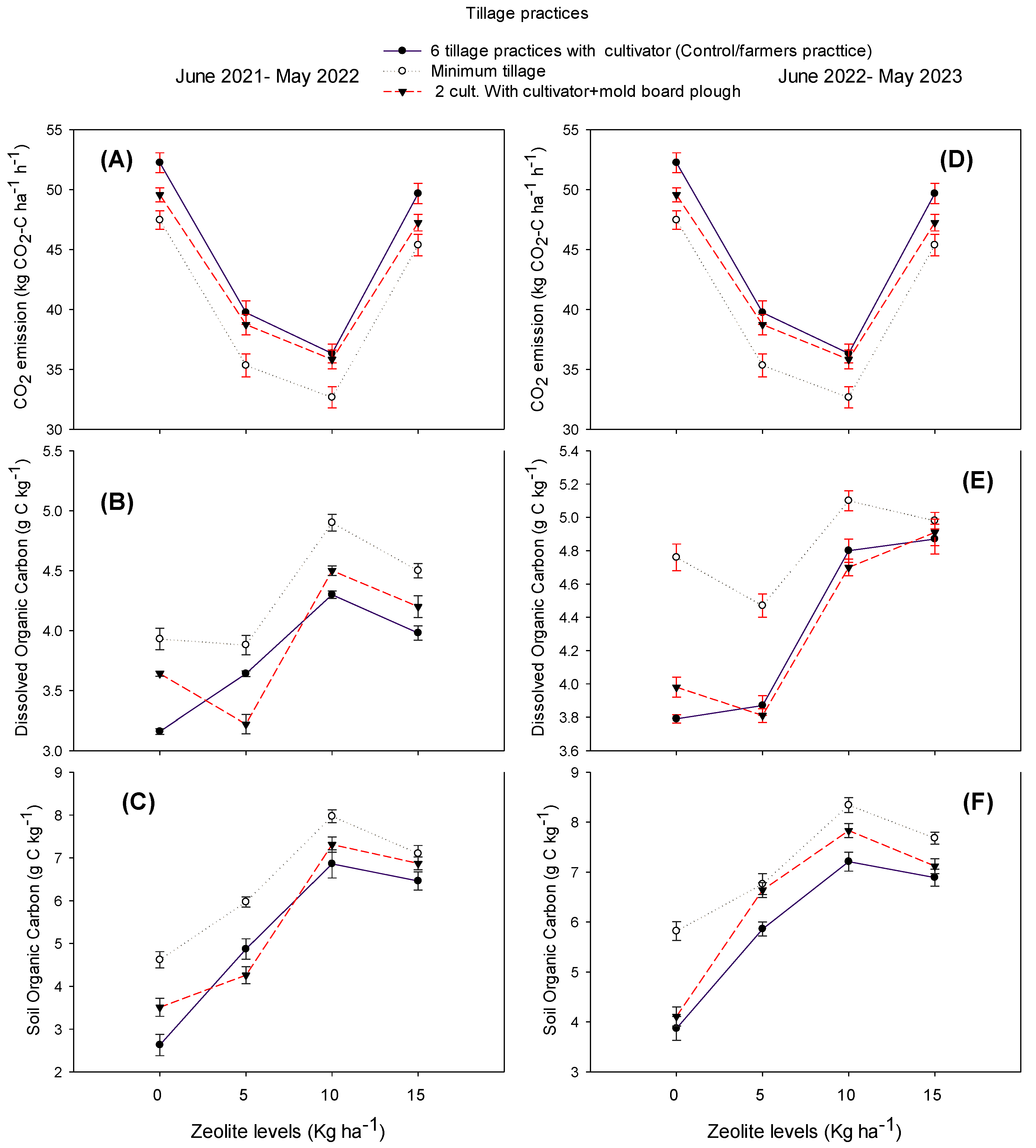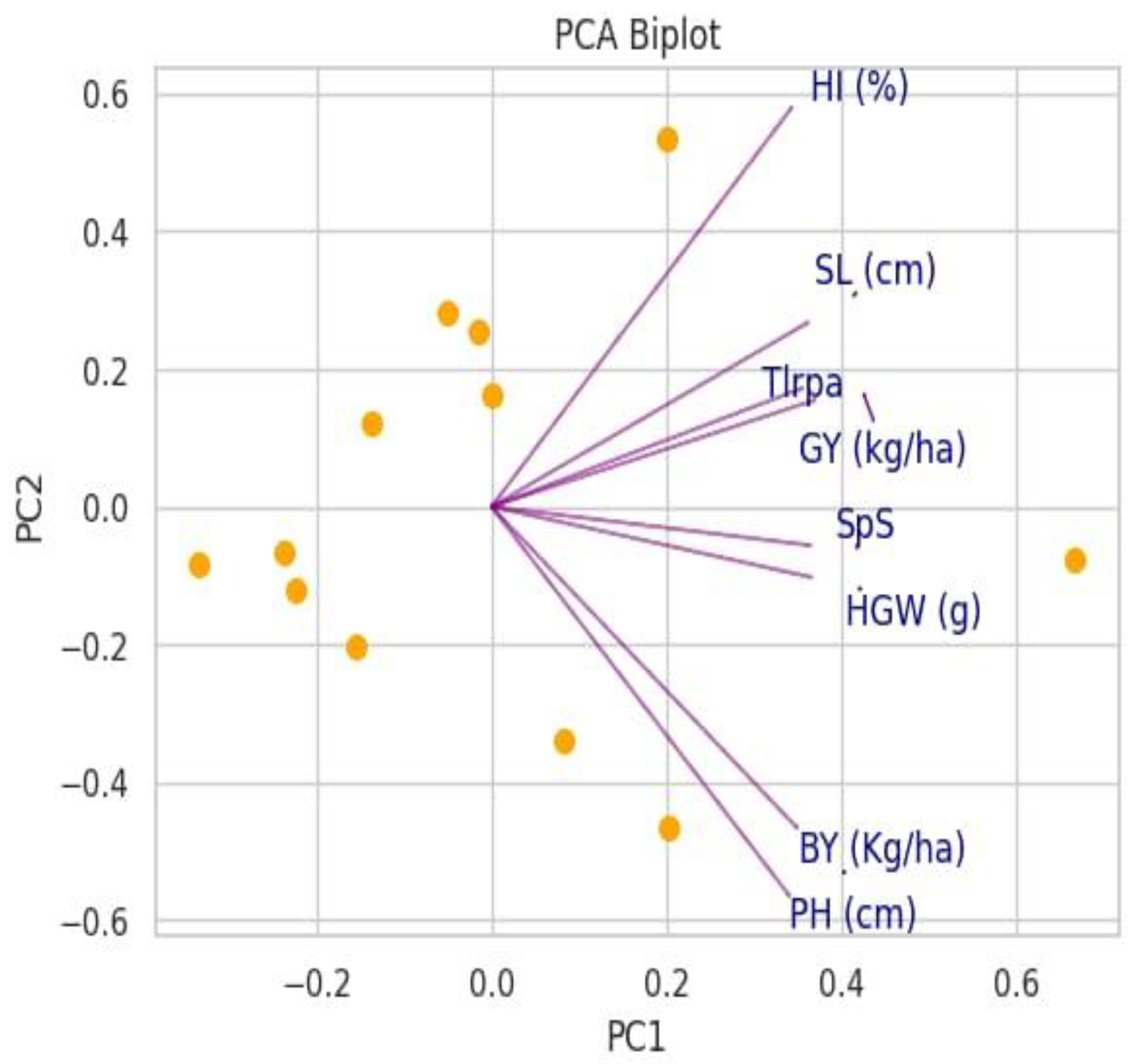Improving Wheat Yield with Zeolite and Tillage Practices under Rain-Fed Conditions
Abstract
:1. Introduction
2. Materials and Methods
2.1. Soil Sampling
2.2. Carbon Emission
2.3. Dissolved Organic Carbon
2.4. Soil Organic Carbon
2.5. Plant Data Collection and Analysis
3. Results
3.1. Correlation Analysis
3.2. Principal Component Analysis
4. Discussion
5. Conclusions
Author Contributions
Funding
Data Availability Statement
Conflicts of Interest
References
- GOP. Economic Survey of Pakistan; Finance and Economic Affairs Division: Islamabad, Pakistan, 2022. [Google Scholar]
- Abu, M.S. Comparative evaluation of cassava composite flours and bread. Asian J. Nat. Prodt. Biochem. 2023, 21, 13–17. [Google Scholar] [CrossRef]
- Ryan, J.; Masri, S.; Ibrikci, H.; Singh, M.; Pala, M.; Harris, H.C. Implications of cereal-based crop rotations, nitrogen fertilization, and stubble grazing on soil organic matter in a Mediterranean-type environment. Turk. J. Agric. For. 2008, 32, 289–297. [Google Scholar]
- Bonfil, D.J.; Mufradi, I.; Klitman, S.; Asido, S. Wheat grain yield and soil profile water distribution in a no-till arid environment. Agron. J. 1999, 91, 368–373. [Google Scholar] [CrossRef]
- Sharma, P.; Abrol, V.; Sharma, K.R.; Sharma, N.; Phogat, V.K.; Vikas, V. Impact of conservation tillage on soil organic carbon and physical properties–a review. Int. J. Bio-Resour. Stress Manag. 2016, 7, 151–161. [Google Scholar] [CrossRef]
- Ullah, I.; Muhammad, D.; Mussarat, M.; Khan, S.; Adnan, M.; Fahad, S.; Ismail, M.; Mian, I.A.; Ali, A.; Saleem, M.H.; et al. Comparative effects of biochar and NPK on wheat crops under different management systems. Crop. Pasture Sci. 2022, 74, 31–40. [Google Scholar] [CrossRef]
- Singh, S.; Prasanna, R.; Pranaw, K. Bioinoculants: Biological Option for Mitigating global Climate Change; Springer Nature: Berlin/Heidelberg, Germany, 2023. [Google Scholar]
- Singh, O.P.; Singh, P.K. Environmental and socio-economic impact of zero-tillage in indo-gangatic plain of uttar pradesh, India. Int. J. Agric. Stat. Sci. 2020, 16, 589. [Google Scholar]
- Higashida, S.; Yamagami, M. Effects of deep plowing with concomitant application of farm yard manure on the productivity of arable crops. Bull. Hokkaido Prefect. Agric. Exp. Stat. 2003, 84, 55–64. [Google Scholar]
- Sfechiș, S.; Vidican, R.; Sandor, M.; Stoian, V.; Sandor, V.; Muste, B. Using assessment of zeolite amendments in agriculture. ProEnvironment 2015, 8, 21. [Google Scholar]
- Abdi, G.H.; Khosh-Khui, M.; Eshghi, S. Effects of natural zeolite on growth and flowering of strawberry (Fragaria × ananassa Duch.). Int. J. Agric. Res. 2010, 5, 799–804. [Google Scholar]
- Li, Z.; Zhang, Y.; Li, Y. Zeolite as slow-release fertilizer on spinach yields and quality in a greenhouse test. J. Plant Nutr. 2013, 36, 1496–1505. [Google Scholar] [CrossRef]
- Bybordi, A.; Elnaz, E. Growth, yield and quality components of canola fertilized with urea and zeolite. Commun. Soil Sci. Plant Anal. 2013, 44, 2896–2915. [Google Scholar] [CrossRef]
- Bernardi, A.C.d.C.; de Souza, G.B.; Polidoro, J.C.; Paiva, P.R.P.; Monte, M.B.d.M. Yield, quality components, and nitrogen levels of silage corn fertilized with urea and zeolite. Commun. Soil Sci. Plant Anal. 2011, 42, 1266–1275. [Google Scholar] [CrossRef]
- Xiubin, H.E.; Zhanbin, H. Zeolite application for enhancing water infiltration and retention in loess soil. Resour. Conserv. Recycl. 2001, 34, 45–52. [Google Scholar] [CrossRef]
- Gholamhoseini, M.; Ghalavand, A.; Khodaei-Joghan, A.; Dolatabadian, A.; Zakikhani, H.; Farmanbar, E. Zeolite-amended cattle manure effects on sunflower yield, seed quality, water use efficiency and nutrient leaching. Soil Tillage Res. 2013, 126, 193–202. [Google Scholar] [CrossRef]
- Hazrati, S.; Tahmasebi-Sarvestani, Z.; Mokhtassi-Bidgoli, A.; Modarres-Sanavy, S.A.M.; Mohammadi, H.; Nicola, S. Effects of zeolite and water stress on growth, yield and chemical compositions of Aloe vera L. Agric. Water Manag. 2017, 181, 66–72. [Google Scholar] [CrossRef]
- Ozbahce, A.; Tari, A.F.; Gönülal, E.; Simsekli, N.; Padem, H. The effect of zeolite applications on yield components and nutrient uptake of common bean under water stress. Arch. Agron. Soil Sci. 2015, 61, 615–626. [Google Scholar] [CrossRef]
- Zahedi, H.; Noormohammadi, G.; Rad, A.S.; Habibi, D.; Boojar, M.M.A. The effects of zeolite and foliar applications of selenium on growth, yield and yield components of three canola cultivars under drought stress. World App. Sci. J. 2009, 7, 255–262. [Google Scholar] [CrossRef]
- Zhang, M.; Hanna, M.; Li, J.; Butcher, S.; Dai, H.; Xiao, W. Creation of a hyperpermeable yeast strain to genotoxic agents through combined inactivation of PDR and CWP genes. Toxicol. Sci. 2010, 113, 401–411. [Google Scholar] [CrossRef]
- Muhammad, A.; Amjad, A.; Parimala, G.S.; Arockiam, J.; Saqi, B.; Qaiser, H.; Fazli, W.; Esmat, F.A.; Hamada, A.; Ronghua, L.; et al. Effects of sheep bone biochar on soil quality, maize growth, and fractionation and phyto-availability of Cd and Zn in a mining-contaminated soil. Chemosphere 2021, 282, 10–16. [Google Scholar] [CrossRef]
- Nelson, D.A.; Sommers, L. Total carbon, organic carbon, and organic matter. Met. Soil Anal. Part 2 Chem. Microbiol. Prop. 1983, 9, 539–579. [Google Scholar]
- Spiertz, J.H.J. Nitrogen, sustainable agriculture and food security: A review. Sustain. Agric. 2010, 30, 43–55. [Google Scholar] [CrossRef]
- Peng, S.; Buresh, R.J.; Huang, J.; Zhong, X.; Zou, Y.; Yang, J.; Dobermann, A. Improving nitrogen fertilization in rice by site specific N management. A review. Agron. Sustain. Dev. 2010, 30, 649–656. [Google Scholar] [CrossRef]
- Mahajan, G.; Chauhan, B.S.; Timsina, J.; Singh, P.P.; Singh, K. Crop performance and water-and nitrogen-use efficiencies in dry-seeded rice in response to irrigation and fertilizer amounts in northwest India. Field Crops Res. 2012, 134, 59–70. [Google Scholar] [CrossRef]
- Darko, R.O.; Shouqi, Y.; Junping, L.; Haofang, Y.; Xingye, Z. Overview of advances in improving uniformity and water use efficiency of sprinkler irrigation. Int. J. Agric. Biol. Eng. 2017, 10, 1–15. [Google Scholar]
- Ahmed, O.H.; Sumalatha, G.; Muhamad, A.N. Use of zeolite in maize (Zea mays) cultivation on nitrogen, potassium and phosphorus uptake and use efficiency. Int. J. Phys. Sci. 2010, 5, 2393–2401. [Google Scholar]
- Qi, W.; Guimin, X.; Taotao, C.; Daocai, C.; Ye, J.; Dehuan, S. Impacts of nitrogen and zeolite managements on yield and physicochemical properties of rice grain. Int. J. Agric. Biol. Eng. 2016, 9, 93–100. [Google Scholar]
- Gao, P.; Liu, Y.; Wang, Y.; Liu, X.; Wang, Z.; Ma, L.Q. Spatial and temporal changes of P and Ca distribution and fractionation in soil and sediment in a karst farmland-wetland system. Chemosphere 2019, 220, 644–650. [Google Scholar] [CrossRef]
- Aghaalikhani, M.; Gholamhoseini, M.; Dolatabadian, A.; Khodaei-Joghan, A.; Sadat Asilan, K. Zeolite influences on nitrate leaching, nitrogen-use efficiency, yield and yield components of canola in sandy soil. Arch. Agron. Soil Sci. 2012, 58, 1149–1169. [Google Scholar] [CrossRef]
- Chen, T.; Sun, D.; Zhang, X.; Wu, Q.; Zheng, J.; Chi, D. Impact of water-nitrogen coupling on grain yield, water and nitrogen usage in zeolite-amended paddy field under alternate wetting and drying irrigation. Trans. Chin. Soc. Agric. Eng. 2016, 32, 154–162. [Google Scholar]
- Ranjan, S.; Dasgupta, N.; Singh, S.; Gandhi, M. Toxicity and regulations of food nanomaterials. Environ. Chem. Lett. 2019, 17, 929–944. [Google Scholar] [CrossRef]
- El-Porai, E.S.; Salama, A.E.; Sharaf, A.M.; Hegazy, A.I.; Gadallah, M.G.E. Effect of different milling processes on Egyptian wheat flour properties and pan bread quality. Ann. Agric. Sci. 2013, 58, 51–59. [Google Scholar] [CrossRef]
- Neylon, E.; Arendt, E.K.; Zannini, E.; Sahin, A.W. Fermentation as a tool to revitalize brewers’ spent grain and elevate techno-functional properties and nutritional value in high fibre bread. Foods 2021, 10, 1639. [Google Scholar] [CrossRef] [PubMed]
- Buteler, M.; Gitto, J.G.; Stadler, T. Enhancing the potential use of microparticulate insecticides through removal of particles from raw grain. J. Stored Prod. Res. 2020, 89, 101707. [Google Scholar] [CrossRef]
- Bodroza-Solarov, M.; Rajic, N.; Pezo, L.; Kojic, J.; Krulj, J.; Filipcev, B.; Jevtic-Mucibabic, R. The rheological properties of wheat dough containing zeolite residue. Chem. Ind. Chem. Eng. Q. 2020, 26, 377–384. [Google Scholar] [CrossRef]
- Van Den Noortgate, H.; Sree, S.P.; Ostyn, N.; Lagrain, B.; Roeffaers, M.; Wenseleers, T.; Martens, J.A. Material properties determining insecticidal activity of activated carbon on the pharaoh ant (Monomorium pharaonis). J. Pest Sci. 2019, 92, 643–652. [Google Scholar] [CrossRef]
- Kima, A.S.; Chung, W.G.; Wang, Y.M. Improving irrigated lowland rice water use efficiency under saturated soil culture for adoption in tropical climate conditions. Water 2014, 6, 2830–2846. [Google Scholar] [CrossRef]





Disclaimer/Publisher’s Note: The statements, opinions and data contained in all publications are solely those of the individual author(s) and contributor(s) and not of MDPI and/or the editor(s). MDPI and/or the editor(s) disclaim responsibility for any injury to people or property resulting from any ideas, methods, instructions or products referred to in the content. |
© 2024 by the authors. Licensee MDPI, Basel, Switzerland. This article is an open access article distributed under the terms and conditions of the Creative Commons Attribution (CC BY) license (https://creativecommons.org/licenses/by/4.0/).
Share and Cite
Hassan, M.u.; Shah, S.T.; Basit, A.; Hikal, W.M.; Khan, M.A.; Khan, W.; Tkachenko, K.G.; Brini, F.; Said-Al Ahl, H.A.H. Improving Wheat Yield with Zeolite and Tillage Practices under Rain-Fed Conditions. Land 2024, 13, 1248. https://doi.org/10.3390/land13081248
Hassan Mu, Shah ST, Basit A, Hikal WM, Khan MA, Khan W, Tkachenko KG, Brini F, Said-Al Ahl HAH. Improving Wheat Yield with Zeolite and Tillage Practices under Rain-Fed Conditions. Land. 2024; 13(8):1248. https://doi.org/10.3390/land13081248
Chicago/Turabian StyleHassan, Mehmood ul, Syed Tanveer Shah, Abdul Basit, Wafaa M. Hikal, Mushtaq Ahmad Khan, Waleed Khan, Kirill G. Tkachenko, Faiçal Brini, and Hussein A. H. Said-Al Ahl. 2024. "Improving Wheat Yield with Zeolite and Tillage Practices under Rain-Fed Conditions" Land 13, no. 8: 1248. https://doi.org/10.3390/land13081248





